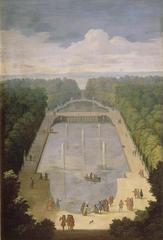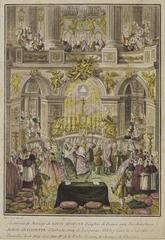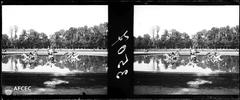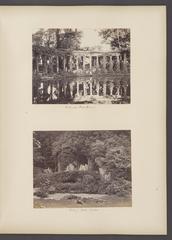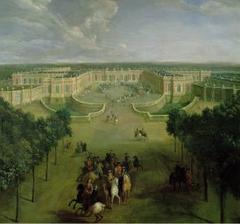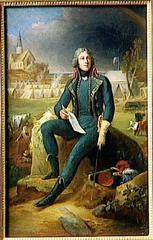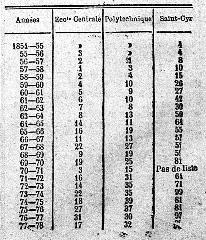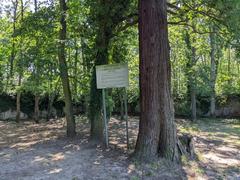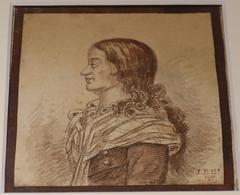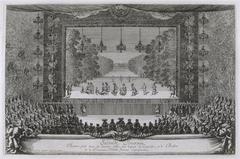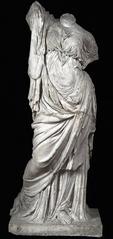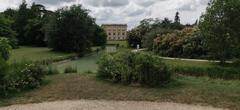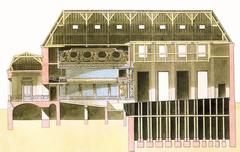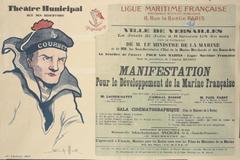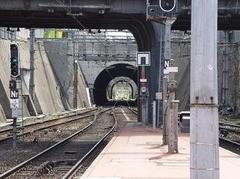
Salle du Jeu de Paume Versailles: Visiting Hours, Tickets, and Historical Significance
Date: 15/06/2025
Introduction: The Legacy of the Salle du Jeu de Paume
A short walk from the opulent Palace of Versailles stands the Salle du Jeu de Paume, a site of immense historical resonance. Built in 1686 as a royal tennis court, this unassuming hall became the unlikely birthplace of modern French democracy during the momentous Tennis Court Oath of June 20, 1789. Today, the Salle du Jeu de Paume is not only a museum reflecting the spirit of the French Revolution but also a living memorial to the enduring ideals of liberty, equality, and fraternity.
This comprehensive guide explores the hall’s history, architectural evolution, visitor information—including hours, ticketing, and accessibility—artistic highlights, and practical tips, ensuring you make the most of your visit to one of Versailles’ most important sites. For official updates and resources, consult the Château de Versailles, Visit Paris Region, and Sortir à Paris.
Table of Contents
- Introduction
- Historical Background
- Architecture and Artistic Features
- Visitor Information
- Visitor Experience
- Nearby Attractions
- Frequently Asked Questions (FAQ)
- Conclusion
- Sources and Further Reading
Historical Background
Construction and Royal Sporting Life
Commissioned in 1686 during Louis XIV’s reign, the Salle du Jeu de Paume was constructed for “jeu de paume,” the precursor to modern tennis (Château de Versailles). The game was a popular aristocratic pastime, and the court’s design—a long, high-ceilinged hall with ample daylight—reflected its athletic purpose. Built for Nicolas Crété, the King’s Tennis Master, it stood apart from the main palace, allowing easy access for the royal family and court.
The Tennis Court Oath of 1789
In June 1789, as revolutionary tensions mounted, deputies of the Third Estate—representing the common people—found themselves locked out of their usual meeting space. They gathered in the Salle du Jeu de Paume and, in a defining moment, swore not to disperse until France had a constitution. This “Serment du Jeu de Paume” marked the dawn of the French Revolution and the assertion of popular sovereignty (Château de Versailles; Visit Paris Region).
Revolutionary Symbolism and Later Use
The hall’s revolutionary symbolism was quickly recognized—a bronze plaque with the oath’s text was installed in 1790. Through the 19th century, the building transitioned through various uses: as a storage depot, a hospice, and an artist’s studio for painters like Antoine-Jean Gros and Horace Vernet (Château de Versailles). Designated a Monument Historique in 1848, the Salle du Jeu de Paume’s preservation became a matter of national importance.
Restoration and Museum Era
Major restoration began in the late 19th century, led by architect Edmond Guillaume. The goal: recapture the hall’s 1789 appearance. Restored features include a Doric aedicule, commemorative sculptures, and a monumental painting based on Jacques-Louis David’s sketches (Château de Versailles). Inaugurated as a museum in 1883, the hall has since undergone further renovations, most recently in 2022, to preserve its structure and historic ambiance (Sortir à Paris).
Architecture and Artistic Features
Layout and Restoration
The Salle du Jeu de Paume’s elongated hall, high windows, exposed beams, and whitewashed walls evoke its original function as a tennis court (Triangle Paris). Its 19th-century restoration focused on historical accuracy, including the restoration of the black cement floor and Pompeian red decorative bands (Château de Versailles).
The David Canvas and Memorials
The museum’s centerpiece is a monumental canvas by Luc-Olivier Merson, based on Jacques-Louis David’s famous, unfinished “Serment du Jeu de Paume,” depicting the 578 deputies swearing the historic oath. The northern wall is adorned with busts and sculptures honoring revolutionary leaders, while inscriptions and plaques commemorate the event’s signatories (Paris Crea). The hall’s restrained decor reflects the revolutionary ideal of simplicity and unity.
Visitor Information
Location and Access
Located at 1 rue du Jeu de Paume, 78000 Versailles, the hall is an eight-minute walk from the main palace entrance, in the historic Saint-Louis district. Visitors can reach it easily from the Versailles Château Rive Gauche train station (Château de Versailles).
Opening Hours and Tickets
As of September 2024, the Salle du Jeu de Paume is open Tuesday to Sunday, from 12:30 pm to 6:30 pm (last entry at 6:00 pm). It is closed on Mondays and certain public holidays (Château de Versailles). Admission is free for self-guided visits; guided tours may require advance booking and a ticket.
Accessibility
The site is wheelchair accessible, with step-free entry and adapted restrooms. Visitors with specific needs should contact staff in advance for assistance (Château de Versailles).
Guided Tours and Special Events
Guided tours are available and highly recommended for those seeking in-depth historical and artistic context. Themed tours, such as “Versailles et la République” and “Le Jeu de Paume, de l’esquisse à la salle,” can be booked through the official website or Versailles Tourist Office. Special events and temporary exhibitions are organized throughout the year, especially around the anniversary of the Tennis Court Oath and European Heritage Days (Mysteries Hunt).
Travel Tips
- Arrive early for a quieter experience.
- Dress warmly in winter, as the hall is unheated.
- Wear comfortable shoes and plan to explore nearby attractions.
- Download the Château de Versailles app for digital guides and podcasts.
Visitor Experience
What to Expect
Upon entry, visitors are enveloped in the solemn atmosphere of a space where history was made. The restored hall, monumental painting, and interpretive panels vividly evoke the events of June 20, 1789. The layout recreates the deputies’ original seating, enhancing immersion.
Exhibits and Digital Resources
In addition to the main painting and sculptures, visitors can access digital resources—including QR-coded audio guides, archival images, and a dedicated app tour (Château de Versailles). Materials are available in several languages. Photography (without flash) is permitted.
Nearby Attractions
- Château de Versailles: France’s most famous palace, with extensive gardens and historic interiors.
- Potager du Roi: The King’s Kitchen Garden, a UNESCO-listed site.
- Saint-Louis Cathedral: A baroque 18th-century church.
- Local Markets and Cafés: The bustling Saint-Louis district offers shops, markets, and eateries.
Frequently Asked Questions (FAQ)
Q: What are the current opening hours?
A: Tuesday to Sunday, 12:30 pm to 6:30 pm; closed Mondays and some holidays.
Q: Is admission free?
A: Yes, self-guided visits are free. Guided tours may require tickets.
Q: Do I need to book in advance?
A: No booking is needed for self-guided visits. Guided tours require advance reservation.
Q: Is the site accessible for people with disabilities?
A: Yes, with step-free access and adapted facilities.
Q: Can I take photos inside?
A: Non-flash photography is generally permitted.
Conclusion
The Salle du Jeu de Paume is more than just a preserved hall—it is a living monument to democratic ideals and the transformative events of 1789. Through its architecture, art, and commemorative displays, it invites visitors to reflect on the enduring values of liberty and unity that continue to shape France. Free, accessible, and deeply evocative, the Salle du Jeu de Paume is an essential stop for anyone exploring the history and spirit of Versailles.
For the most current information, download the Château de Versailles app or consult the official website. Make your visit memorable by joining a guided tour, exploring digital resources, and reflecting on the revolutionary energy that still echoes within these historic walls.
Sources and Official Links
- Château de Versailles – Royal Tennis Court
- Triangle Paris – Salle du Jeu de Paume History
- Paris Crea – Free Visit Guide
- Château de Versailles – Visiting Information
- Sortir à Paris – Guided Tour Article
- France Culture – Memory of the Site
- Mysteries Hunt – Revolution Tour
- Visit Paris Region – Salle du Jeu de Paume

